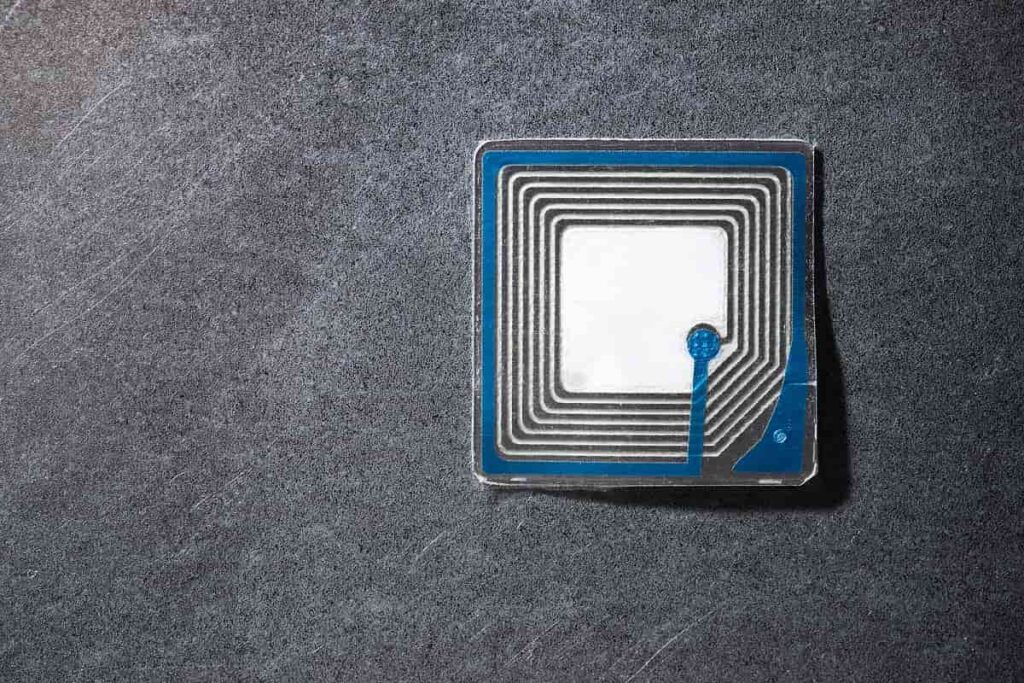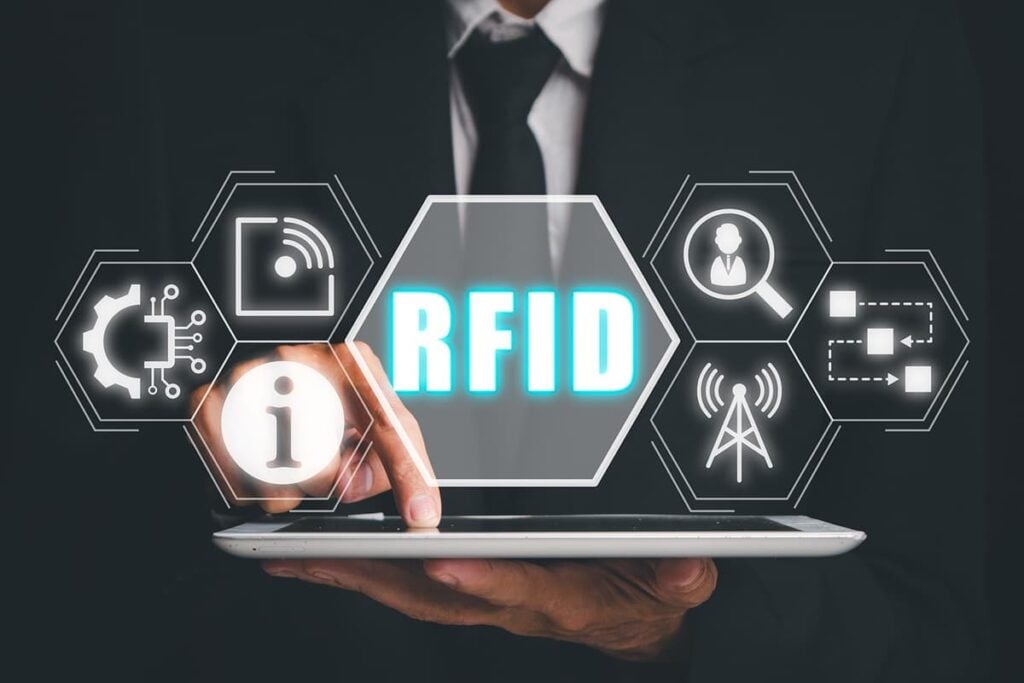A Pure-Play RFID Stock for IoT Investors
Table of contents

Over our many years of writing about disruptive technologies, we can never predict what sort of response our content will elicit. We’re not just talking about the cease-and-desist threats we get from penny stocks we write about, we’re talking about some downright spooky stuff. No article we’ve written has elicited more interesting emails than our piece on Who Makes the RFID Chip Implants for Humans? We actually wrote about this in a follow-up piece titled How To Go About Treating Schizophrenia.
Long story short, some people suffering from mental disorders believe that they’re being tracked. When they come across our article on using Radio frequency identification (RFID) tags for humans, they naturally want to know more about the companies involved. (Whenever this happens, we always try to gently suggest that they get some opinions from multiple mental health professionals.) It just goes to show how pervasive RFID has become that it’s even the technology of choice for paranoid schizophrenics. Today, we’re going to talk about a pure-play stock that’s using RFID technology for non-human applications – Impinj (PI).
What is RFID?
RFID or radio frequency identification is pretty much what it says on the tin. It’s the ability to track an item based on an RFID tag which is comprised of a tag chip (sometimes called an integrated circuit or IC) attached to an antenna that is then affixed to a substrate and attached to an item (or even embedded inside an item).

Active RFID tags are battery powered (expensive) and passive RFID tags are powered by radio waves (cheap), which is why most commonly used RFID tags are passive. A hardware device called an RFID reader can then read the tags at speeds of up to 1,000 items per second, at distances of up to 10 yards (10 meters).

Given we’re now able to create synthetic life, it seems reasonable to think that most products being sold today are being tracked. That’s hardly the case. According to Impinj, about 0.2% of all connectable items are actually connected.

Every year, trillions of items could be equipped with IoT tags that would improve supply chain management and help the end retailer with asset tracking and inventory management. For example, taking inventory with an RFID handheld reader is 25X faster than reading barcode labels with a barcode reader. Think about how much savings a retail store could realize if they didn’t have to do manual stocktaking.
A Pure-Play RFID Stock
Do some cursory research on who the leaders in RFID are and one name will keep popping up – Impinj. It’s a little company we first looked at back in 2016 when they first offered their shares to the public. Today, we want to see what sort of opportunity Impinj presents for IoT investors who believe that RFID is a key part of the IoT revolution.
You’ll see Impinj talk a lot about RAIN RFID which is a technology standard adopted by 160-member companies around the globe – the RAIN Alliance – which promotes the universal adoption of RFID technology. RAIN RFID is used to connect “billions of everyday items to the internet, enabling businesses and consumers to identify, locate, authenticate, and engage each item.” A universal set of standards allows many different companies to play in the same ecosystem. For example, a company can build RFID tags that conform to RAIN RFID standards and these could be read by Impinj’s RFID readers – or vice versa.
While Impinj provides a full-stack solution – endpoints, readers, gateways, and software – their bread and butter is in the actual RFID tags called endpoint integrated circuits (ICs) – or endpoints for short. These tiny devices are powered by radio waves so they do not need a battery, can wirelessly connect almost any item, are readable at distances up to 10 yards (10 meters) without line-of-sight, and sell for pennies. You can also embed other functionality in RFID tags such as user data storage, security, authentication, loss prevention, privacy protection, and other custom applications, all of which can be managed via the Impinj RFID software platform.
Impinj and the Growth of RFID
From 2010 to 2019, Impinj’s endpoint sales volumes increased at a compounded annual growth rate (CAGR) of 28%, showing that RAIN RFID is being adopted at a rapid pace. However, revenues don’t necessarily match that growth because endpoints are subject to price erosion over time as technology makes them cheaper to produce. The cheaper the endpoint, the more products it can be affixed to. That’s why we need to pay attention to endpoint growth and revenue growth.
From 2015 to 2019, Impinj managed to grow their revenues at an 18.1% CAGR.

As we would expect, their Q2-2020 revenues fell off a cliff as “the Rona” wreaked some havoc on global retail apparel sales which Impinj says “normally account for roughly two-thirds of our endpoint IC volumes.” In a recent investor deck, we see that Impinj tags adorn “12 billion apparel items annually” with “68 billion to go,” implying they have a market share of about 15% for the retail apparel RFID niche. This also implies that around 65% of all tags sold by Impinj are for retail apparel applications.
The Competition
Impinj believes they’re the only firm out there providing a full-stack solution, from endpoints to gateways. Competitors they list in their latest 10-K include the following names:
- Endpoint ICs – NXP, and Alien.
- Reader ICs – STMicroelectronics, Phychips Inc, IoTelligent, and MagicRF
- Readers and Gateways – Alien and Zebra.
- Software – Zebra and Mojix
Impinj is presently in a legal tussle with NXP (NXPI) which started in June 2019 when Impinj asserted infringement on 26 endpoint-related patents. NXP responded with their own eight-patent infringement lawsuit four months later.
An outside look at available resources shows NXP with 31,000 employees, one-third of whom are engineers, and Impinj with 272 employees. Says Impinj’s Founder and CEO, Chris Diorio:
For two years we have tried to resolve this matter out of court. Disappointingly, NXP repeatedly refused to meet with us to address the issue. Consequently, we were left with no choice but to file this lawsuit.
Credit: Impinj CEO Letter
It’s probably safe to say that during those two years, NXP was quietly mounting their counter attack. You can read their complaint of eight patent infringements at this link.
Any number of outcomes are possible, including a situation where both companies settle out of court instead of pouring money into the coffers of the legal offices they’ve employed to do battle. The risks for Impinj are high given the company states, “We derive, and expect to continue to derive, a majority of our product revenue from our endpoint ICs.”
From where we sit, Impinj falls outside our minimum $1 billion market cap requirement. Their ongoing legal tussle is a good example of why we don’t like to invest in small companies. They often lack the resources needed to grow their business while managing the all-consuming task of battling a company in court that is – in the case of Impinj vs. NXP – over 70X their size by market cap. The uncertainty surrounding these lawsuits creates volatility, which equals risk. As risk-averse investors, we prefer to avoid as many uncontrollable risks as possible.
Conclusion
There’s everything to like about the RFID growth story, and even more to like about Impinj owning a full-stack RFID system. However, we’re not liking the uncertainty that surrounds a legal battle which directly affects a product line that Impinj derives a majority of their revenues from. Once everything gets settled and the two companies part ways, we’ll take a look to see how much closer Impinj is to meeting our minimum $1 billion market cap requirement.
Sign up to our newsletter to get more of our great research delivered straight to your inbox!
Nanalyze Weekly includes useful insights written by our team of underpaid MBAs, research on new disruptive technology stocks flying under the radar, and summaries of our recent research. Always 100% free.
















Thanks for the information aside from the usual propaganda and trying to dismiss as ‘mentally ill’ those who are three dimensional thinkers and understand the direction our world has been heading in for a long time
We understand your sentiment Jason, and we’re just trying to be helpful.